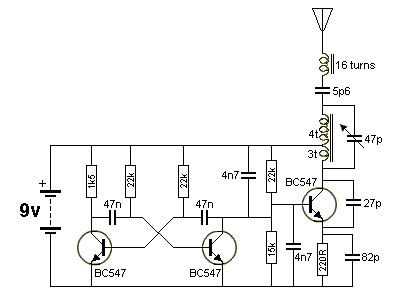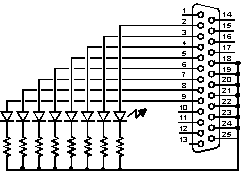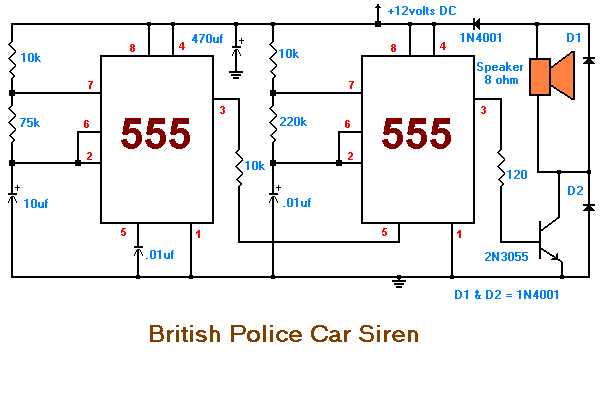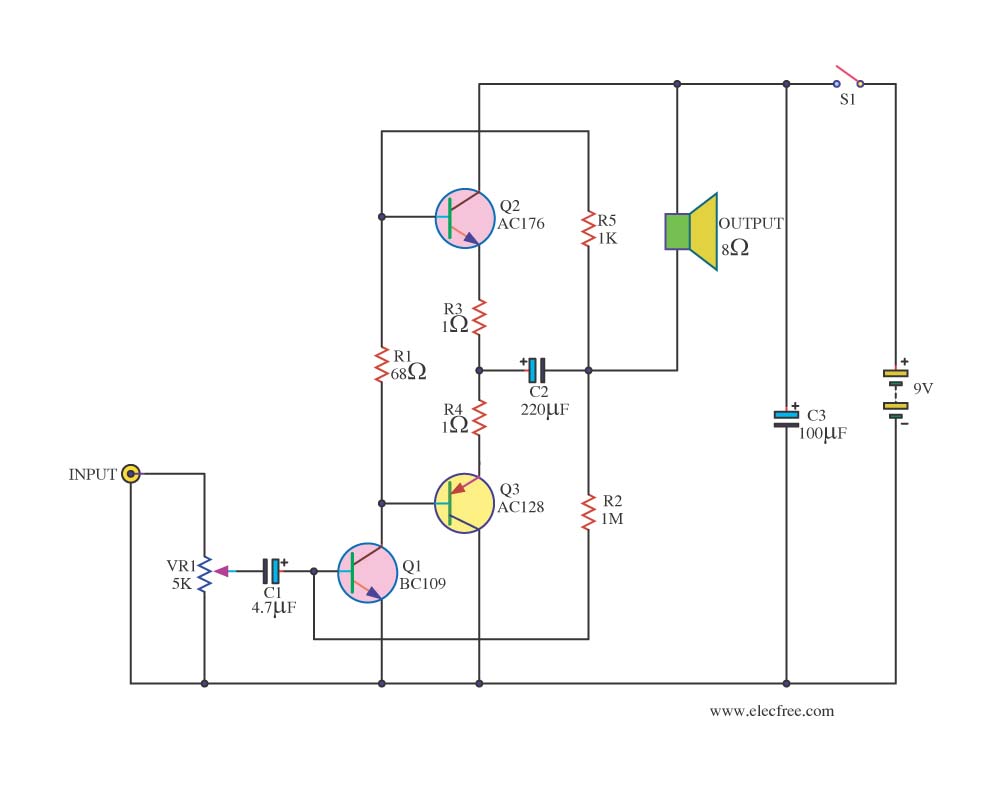
100 transistor circuits

A straightforward method to create a speaker transformer involves winding turns around a ferrite rod. The primary winding consists of 300 turns of 0.01mm wire, which is very fine, wound over the secondary and concluding with a loop of wire referred to as the center tap. This circuit features a highly sensitive three-transistor amplifier utilizing a speaker transformer. It can be wound on a short length of ferrite rod or with 150 turns on a 10mH choke. The biasing for the middle transistor is configured for a 3V supply. During idle conditions, the second and third transistors remain off, resulting in a quiescent current of just 5mA. This circuit is among the simplest available. A second transistor replaces the need for physical contact; it possesses a gain of approximately 200. When a user touches specific points indicated in the diagram, an LED illuminates with minimal contact. The transistor amplifies the current from the user's fingers by about 200 times. The circuit's sensitivity allows it to detect "mains hum," enabling it to locate mains cables by simply moving it across any wall. Its overall gain reaches approximately 6,000,000, allowing it to sense static electricity and the presence of a hand without direct contact. The circuit's input is classified as very high impedance.
This circuit design emphasizes the utility of a ferrite rod as a transformer core, which is crucial for efficient electromagnetic induction. The choice of 0.01mm wire for the primary winding ensures a high number of turns can be accommodated, enhancing the inductive coupling between the primary and secondary windings. The center tap is an essential feature, allowing for a balanced output and facilitating the connection of the circuit to other components.
The three-transistor amplifier configuration is notable for its low power consumption, as indicated by the quiescent current of 5mA. The first transistor serves as the input stage, which is biased to operate optimally at a 3V supply. The second and third transistors function as amplification stages, contributing to the circuit’s overall gain. The gain of 200 from the second transistor implies that even minute changes in input current can produce significant output changes, making this circuit exceptionally sensitive.
The ability to detect mains hum and static electricity demonstrates the circuit's high impedance input, which allows it to respond to very small signals without loading the source. This characteristic is particularly useful in applications where signal integrity is paramount. The circuit's performance can also be influenced by environmental factors, such as nearby electrical devices, which can induce additional signals.
In practical applications, the circuit can be utilized in various sensing tasks, including proximity detection and environmental monitoring. Its simple construction allows for easy replication and experimentation, making it an excellent project for both educational purposes and hobbyist electronics. Overall, this circuit exemplifies the principles of amplification and sensitivity in electronic design, showcasing how basic components can be combined to achieve remarkable functionality.A simple way to produce your own speaker transformer by winding turns on a piece of ferrite rod. The primary winding is made by winding 300 turns of 0. 01mm wire (this is very fine wire) over the secondary and ending with a loop of wire we call the centre tap. This circuit is a very sensitive 3-transistor amplifier using a speaker transformer. This can be wound on a short length of ferrite rod as show above or 150 turns on a 10mH choke. The biasing of the middle transistor is set for 3v supply. The second and third transistors are not turned on during idle conditions and the quiescent current is just 5mA. This the second simplest circuit in the world. A second transistor has been added in place of your fingers. This transistor has a gain of about 200 and when you touch the points shown on the diagram, the LED will illuminate with the slightest touch.
The transistor has amplified the current (through your fingers) about 200 times. This circuit is so sensitive it will detect "mains hum. " Simply move it across any wall and it will detect where the mains cable is located. It has a gain of about 200 x 200 x 200 = 6, 000, 000 and will also detect static electricity and the presence of your hand without any direct contact. You will be amazed what it detects! There is static electricity EVERYWHERE! The input of this circuit is classified as very high impedance. This circuit can be 🔗 External reference
This circuit design emphasizes the utility of a ferrite rod as a transformer core, which is crucial for efficient electromagnetic induction. The choice of 0.01mm wire for the primary winding ensures a high number of turns can be accommodated, enhancing the inductive coupling between the primary and secondary windings. The center tap is an essential feature, allowing for a balanced output and facilitating the connection of the circuit to other components.
The three-transistor amplifier configuration is notable for its low power consumption, as indicated by the quiescent current of 5mA. The first transistor serves as the input stage, which is biased to operate optimally at a 3V supply. The second and third transistors function as amplification stages, contributing to the circuit’s overall gain. The gain of 200 from the second transistor implies that even minute changes in input current can produce significant output changes, making this circuit exceptionally sensitive.
The ability to detect mains hum and static electricity demonstrates the circuit's high impedance input, which allows it to respond to very small signals without loading the source. This characteristic is particularly useful in applications where signal integrity is paramount. The circuit's performance can also be influenced by environmental factors, such as nearby electrical devices, which can induce additional signals.
In practical applications, the circuit can be utilized in various sensing tasks, including proximity detection and environmental monitoring. Its simple construction allows for easy replication and experimentation, making it an excellent project for both educational purposes and hobbyist electronics. Overall, this circuit exemplifies the principles of amplification and sensitivity in electronic design, showcasing how basic components can be combined to achieve remarkable functionality.A simple way to produce your own speaker transformer by winding turns on a piece of ferrite rod. The primary winding is made by winding 300 turns of 0. 01mm wire (this is very fine wire) over the secondary and ending with a loop of wire we call the centre tap. This circuit is a very sensitive 3-transistor amplifier using a speaker transformer. This can be wound on a short length of ferrite rod as show above or 150 turns on a 10mH choke. The biasing of the middle transistor is set for 3v supply. The second and third transistors are not turned on during idle conditions and the quiescent current is just 5mA. This the second simplest circuit in the world. A second transistor has been added in place of your fingers. This transistor has a gain of about 200 and when you touch the points shown on the diagram, the LED will illuminate with the slightest touch.
The transistor has amplified the current (through your fingers) about 200 times. This circuit is so sensitive it will detect "mains hum. " Simply move it across any wall and it will detect where the mains cable is located. It has a gain of about 200 x 200 x 200 = 6, 000, 000 and will also detect static electricity and the presence of your hand without any direct contact. You will be amazed what it detects! There is static electricity EVERYWHERE! The input of this circuit is classified as very high impedance. This circuit can be 🔗 External reference





